Baking soda (sodium bicarbonate) is a kitchen staple that can work wonders to clean clothes, appliances, and even drains that are smelly or clogged.
A naturally occurring mineral compound, baking soda can dissolve mineral deposits and organic materials such as grease. Baking soda has slight disinfectant properties to combat odor-causing bacteria and fungi. Regular cleaning with baking soda may prevent clogs from forming. Before using chemical drain cleaners or disassembling the drain trap, try baking soda to see if it does the trick.
What You’ll Need
Equipment / Tools
- Pot
- Funnel
Materials
- Boiling water
- Dish soap
- Baking soda
- Distilled white vinegar
- Salt
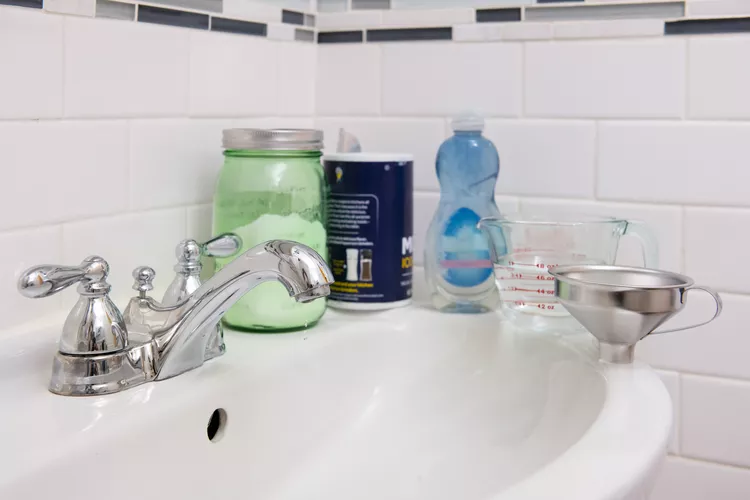
How to Unclog a Drain with Baking Soda and Vinegar
Heat Boiling Water
Heat boiling water in a tea kettle on the stovetop or in a large pourable measuring cup in the microwave.
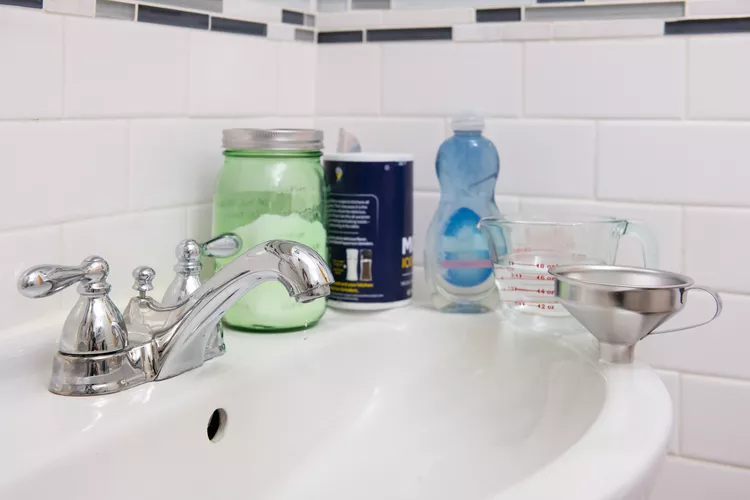
Pour Boiling Water and Dish Soap Into Drain
Squirt a bit of grease-fighting dish soap into the drain and carefully pour the boiling water down the drain. The dish soap will help dissolve greasy clogs.
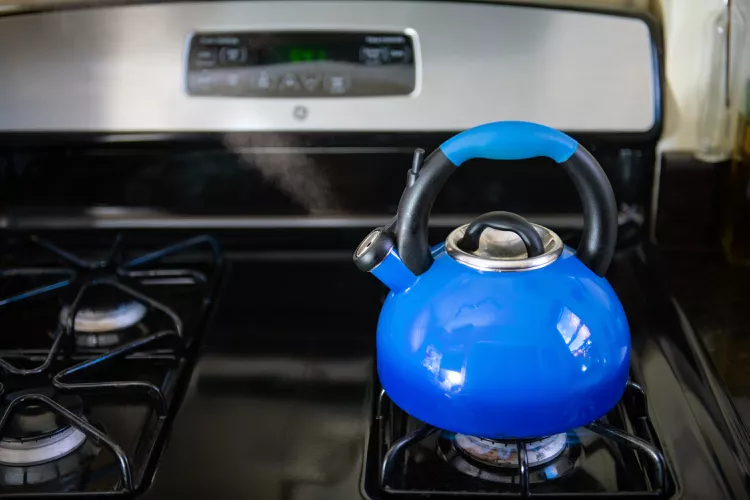
Pour Baking Soda Into the Drain
Pour one cup of baking soda into the drain. You can use a measuring cup to do this or use a funnel if you have a smaller drain that makes it hard to pour directly into the drain opening.
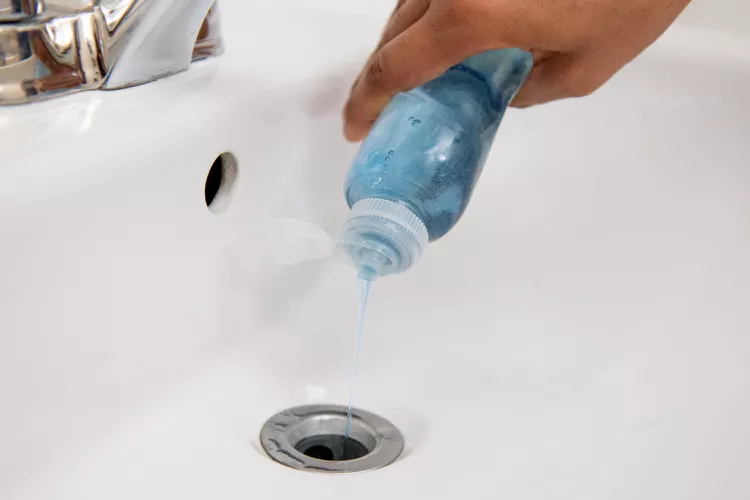
Follow With Vinegar
Pour one cup of distilled white vinegar into the drain. Don’t be surprised by the audible reaction that occurs. Baking soda is an alkaline substance and vinegar is a mild acetic acid. When the two are mixed, they react somewhat dramatically to neutralize one another; the fizzing action you hear is the reaction that will often dislodge clogs in your drain.
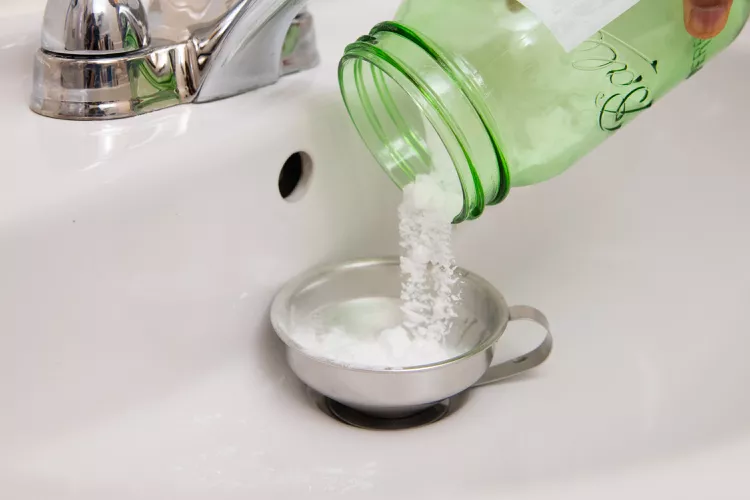
Flush With More Hot Water
After the fizzing subsides, wait five minutes. Use this time to heat two cups of water to boiling. Flush the drain with this additional boiling water.
If the drain is now flowing, run hot tap water to flush all debris down the drain. If it is not draining, repeat the previous steps. If you haven’t cleaned your drain recently, it may be necessary to repeat the baking soda flush at least twice.
If a drain clog doesn’t clear after two or more attempts, use the baking soda and salt method described below.
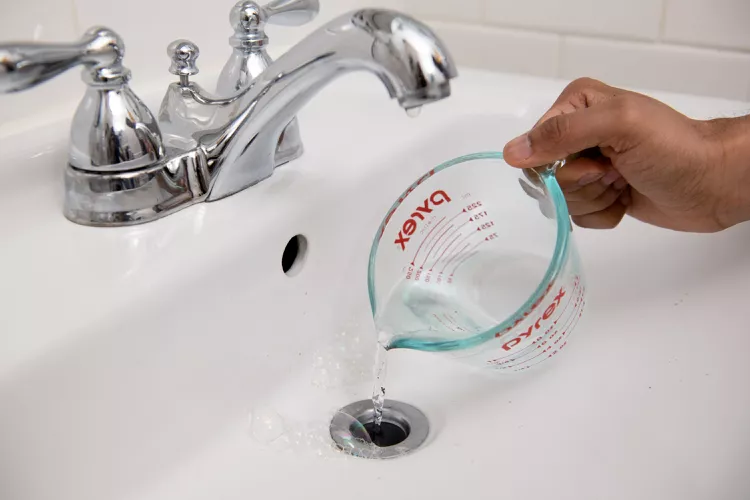
How to Clean a Clogged Drain With Salt and Baking Soda
If the baking soda and vinegar method doesn’t unclog the drain, use the salt and baking soda method next. This works best if you do it right before bedtime since the drain won’t be used until morning.
Pour Baking Soda Into the Drain
Pour one cup of baking soda into the clogged drain.
Pour Salt Into the Drain
Follow the baking soda with 1/2 cup of salt poured into the drain. Let this mixture sit in the drain for several hours—overnight is best.
Flush With Boiling Water
In the morning, heat two cups of water to a boil, then pour this hot water into the drain.
Flush With Tap Water
If the drain begins to drain, continue to flush with hot tap water. If not, you may need to repeat the process or try the baking soda and vinegar method.
If neither baking soda method opens the drain, it is likely you’ll need to disassemble the drain trap to clear the clog.
How Often to Clean Your Drains
Weekly, flush drains with boiling water mixed with liquid grease-fighting dish soap, such as Dawn. Clean your drain with baking soda as soon as you notice the water is draining slowly. You can also use this process as a regular maintenance method for your drains. For example, if you keep a box of open baking soda in your refrigerator to absorb odors, use the old baking soda to flush your kitchen drain when it comes time to change the box.
Here are the various methods with simple steps using baking soda to clean drains.
Tips for Keeping Your Drains Clean
- Always use strainer baskets on your drains to keep hair and food particles from going down the drain.
- Never pour oil or grease down the drain. When cooking greasy or oily foods, wipe the cookware with a paper towel before washing so less grease, oil, and fat go down the drain to form a clog.
- Regularly add boiling water with a grease-fighting dish soap down the drain to prevent the buildup of greasy clogs.
- Both the baking-soda-and-vinegar and the baking-soda-and-salt methods can be used to clean and freshen your garbage disposal. To remove odors from a garbage disposal, reduce the required amounts of baking soda, water, vinegar, and salt by half and follow the directions above.


This method of unclogging drains with baking soda and vinegar is a game-changer! I appreciate the natural and chemical-free approach to tackling stubborn clogs. The step-by-step instructions provided make it easy to follow, and the combination of baking soda and vinegar creates a powerful reaction that helps break down grease and debris. Excited to try this eco-friendly solution and say goodbye to clogged drains for good!
Thank you for sharing this effective DIY solution for unclogging drains! The combination of baking soda and vinegar is not only safe and environmentally friendly but also surprisingly powerful in clearing stubborn blockages. I appreciate the tip to follow up with hot water to flush away any remaining residue. With these simple ingredients and easy-to-follow steps, I feel confident I can tackle drain clogs without resorting to harsh chemicals.
I’ve tried this method myself, and it’s surprisingly effective! The combination of baking soda and vinegar creates a fizzy reaction that helps break down clogs and clear drains. It’s a natural and chemical-free alternative to harsh drain cleaners, making it safe for both the environment and household pipes. Plus, most people already have these ingredients on hand, making it a convenient solution for unexpected clogs.
I appreciate the eco-friendly approach to unclogging drains using baking soda and vinegar outlined in this article. Not only is it effective, but it’s also much gentler on pipes compared to commercial drain cleaners. The step-by-step instructions provided make it easy for anyone to try this DIY method at home. It’s a great option for minor clogs and regular drain maintenance, promoting sustainability and reducing reliance on harmful chemicals.
This article offers a simple and cost-effective solution for dealing with clogged drains using common household items. The baking soda and vinegar combination is a classic DIY method that many homeowners swear by for clearing minor drain blockages. I like that the article provides clear instructions on how to use these ingredients effectively, as well as tips for preventative maintenance to keep drains flowing smoothly. It’s a useful resource for anyone looking to tackle drain issues without resorting to harsh chemicals.
Clear your clogged drain naturally with the power of baking soda and vinegar for a simple and effective solution.